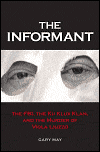 |
Old Bull Lee A Voice From the Reality-based Community Notes from a Study of Things Themselves |
 |
A Troubling Look at the Role of Tommy Rowe in the Murder of Viola Liuzzo
 |
Title:
The Informant: The FBI, the Ku Klux Klan and the Murder of Viola Liuzzo
Author: Gary May Publisher: Yale University Press Publication Date: 2005 Pages: 431 including notes and index plus 15 for contents and preface |
The use of paid informants by this nation's secret political police (FBI, Secret Service, BATF, etc.) has expanded enormously since the FBI engaged the services of Tommy Rowe in the early 1960's.
In the George W. Bush administration, provocateurs and informants were widely employed to entrap "terrorists." They pretended to be from al Qaeda, offering thousands of dollars to anyone who would sign up. Not surprisingly, only the dumbest of dimwits took the bait.
In the Clinton administration, informants were directed to infiltrate "hate groups" and "militias," which were at the time considered to be a mortal danger to civilization. (Interessting that nobody talks about hate groups and militias any more.)
This joke was making the rounds in that era.
There are only two types of people in the Ku Klux Klan: gas station attendants and FBI informants.
How do you tell them apart?
The informants pay their dues.
About that time I heard a radio report that the FBI had 23 on-going investigations of the "neo-Nazi" National Alliance organization. I interpreted this to mean they had 23 paid informants in the National Alliance, probably ten percent of the paid-up membership.
Nowadays police infiltration of politically disfavored fringe groups is so widely recognized that such groups have trouble recruiting anyone with an IQ over 90. Maybe that's what the DOJ wants to achieve.
A successful entrapment by an informant is rewarding not only to the informant, but to the police, who get favorable public relations by appearing to protect the public; to the prosecutor, who gets a career boost; and to the Department of Justice, which earns credit from politicians who make an issue of the danger from fringe groups. Finally, nonprofit organizations, such as the Anti-Defamation League (ADL) and Southern Poverty Law Center (SPLC), exploit the publicity to frighten the public and raise money.
Before discussing Gary May's book about Tommy Rowe, it's useful to review some other high-profile cases where the political police have used paid informants.
In 1990 Marion Barry, as mayor of Washington, D.C., became a target of the Department of Justice and they used an informant to entrap him into smoking crack cocaine in a hotel room. The informant, Rasheeda Moore, described as a "former model," lured Barry to her room in the Vista Hotel in Washington about 7:30 pm on January 18, 1990. Unknown to Barry three TV cameras were recording every sound and action in the room and four Federal agents were waiting next door to make the bust. At the subsequent trial, the feds used the tape as evidence and, incredibly, released the tape to the public. C-SPAN broadcast the tape without much comment.
The 90-minute tape reveals a paid informant in action. It opens with Barry and Moore in a hotel room. Each of them seems pretty relaxed as they pour themselves drinks from a bottle on the dresser. They sit on the bed, engaging in flirtatious banter, reminiscing about old times and gossiping about mutual acquaintances.
After about thirty minutes, the phone rings and Moore answers. She tells Barry that she has the opportunity to score some cocaine and her connection can bring it to the hotel. Barry acknowledges this but seems indifferent. Moore suggests that if their encounter is going to go beyond flirting, she's going to need some crack. They continue their drinking and laughing. A short while later, the female connection knocks on the door and Moore invites her in. Moore and the female disappear from view, perhaps into the bathroom, while Barry sits on the bed staring at the TV. After a couple of minutes, Moore comes out and tells Barry that the connection wants some money for the cocaine and asks Barry for cash. Barry gets out his billfold and hands over money to Moore, who goes back into the bathroom. The connection, who Barry never interacts with, can be seen exiting the hotel room. Moore comes back into view with the cocaine.
She brings out her crack pipe and suggests that Barry take a smoke. Barry goes along but seems unfamiliar with smoking crack from a pipe. So Moore instructs him how to do it. Eventually he manages to light the pipe and take a big drag. Seconds later the federal agents burst into room and arrest Barry as Moore disappears out the door. The agents make an issue of Barry's health and immediately measure his pulse and blood pressure. Barry says he feels fine, but he's pissed off. "That bitch set me up," he says several times.
A local jury seemed to agree. They watched the tape of the informant suggesting the crack, arranging to buy the crack, negotiating with the crack dealer, preparing the crack for smoking and putting the crack pipe in Barry's hands. They acquitted Barry of all charges except the least serious drug offense.
Randy Weaver, a poor white guy who lived with his family in an isolated cabin in northern Idaho, was spotted at a meeting of "white separatists" and selected as target for persecution even though he wasn't a member of any organizations. The Bureau of Alcohol, Tobacco and Firearms (BATF) sent an informant to Weaver's house for the purpose of entrapping him. Weaver, at the informant's request, sawed off a shotgun barrel half an inch shorter than the law allowed and was charged with violating a federal statute.
When Weaver failed to appear in court to answer the charge--he claimed he didn't get the notice in the mail--the FBI dispatched a swat team to his residence. When the team arrived, dogs started barking and Weaver's 14-year old son came outside with a rifle, suspecting a wild animal was causing the disturbance. When he saw he was surrounded by armed men, he fled back to the house, but never made it. He was shot in the back by an FBI sniper and died on the spot. (I thought it was illegal for a cop to shoot a fleeing suspect in the back. Maybe those laws don't apply to the FBI.)
Weaver and his family believed they were besieged by madmen and holed up in the house. At one point FBI sniper Lon Horuchi shot Randy Weaver's wife to death as she stood in a doorway holding her infant child. Eventually, the remaining members of Weaver's family were allowed to peacefully emerge from the house.
At a subsequent trial, Weaver was acquitted of all gun-related charges but paid a small fine for failing to appear in court. No one from the FBI or DOJ was ever charged with a crime or suffered career damage from this outrage, but the FBI's actions were so egregious and the publicity so widespread that Weaver was eventually able to get the government to pay him three million dollars in damages. Such was the cost of DOJ's use of a paid informant.
It's widely believed that the existence of certain informants complicated the government's prosecution of Timothy McVeigh and Terry Nichols and prevented prosecution of McVeigh's helpers in constructing his 4800 pound truck bomb. Testimony by those informants would have weakened the government's case against McVeigh and Nichols by giving the defense an argument that the government had foreknowledge of the bombing or was complicit in it.
(It's hard to imagine how such a heavy bomb could be assembled and loaded onto a truck by one person alone. Indeed, several eyewitnesses testified in court that they saw McVeigh and others mixing up the bomb ingredients. The "others" were never prosecuted. Likewise, the government never identified or prosecuted "John Doe #2", McVeigh's companion in renting the truck.)
After the bombing, independent researchers quickly discovered McVeigh's connection with Elohim City in eastern Oklahoma, a compound of the Christian Identity movement and haven for violent members of the White Aryan Resistance. Elohim City was the sort of place you would expect to be thoroughly infiltrated by informants, and indeed it was. Robert Millar, the founder and patriarch of Elohim City was on the FBI payroll. Carol Howe, a 23-year old thrill-seeker who filed reports with the ATF, had close relationships with violent members of the compound such as Dennis Mahon and Andreas Strassmeir. The latter individual, an illegal German immigrant, who was well acquainted with Timothy McVeigh and frequently seen in his company, may also have been an informant. Strassmeir was spirited out of the country after the bombing and has never returned.
What is noteworthy is the extraordinary lengths the DOJ went to in order to suppress the connection between Elohim City and Timothy McVeigh and to insure that nothing associated with that compound of informants and nut-cases was introduced as evidence in McVeigh's trial. Details of this rotten story can be found in Ambrose Evans-Pritchard's book The Secret Life of Bill Clinton.
As a recent example, the FBI infiltrated an informant named Tony Evola into an anti-Jewish Christian organization known as World Church of the Creator, of which Matthew Hale was founder and leader. Evola recorded a phone conversation with Hale in which the subject of killing a federal judge was mentioned, the judge having ruled against Hale in a trademark dispute. The Department of Justice used the tape and Evola's testimony to convict Hale of one of the most serious crimes on the books: conspiracy to murder a federal judge. Hale, unable to afford the astronomical cost of a proper defense in federal court or even to talk privately with his attorney because of recently-passed anti-terrorism legislation, was put away for life in solitary confinement. The DOJ prosecutors, naturally, basked in the glory of their success. Michael Chertoff, the government official behind this prosecution, put another notch in his belt and was later rewarded by George W. Bush with an appointment to be head of Homeland Security (a job which he botched disastrously after Hurricane Katrina).
Ironically, a year after Hale started his sentence, two members of that judge's family were murdered by a crazy individual seeking to kill the judge. The crazy individual had no connection whatever with Matthew Hale or the World Church of the Creator. However, hardly anyone asked the obvious question: what's higher on the FBI's priority list, protecting federal judges from dangerous criminals or getting high-profile, career enhancing convictions of politically disfavored individuals for their bosses at the DOJ?
Gary May, a professor of history at the University of Delaware, does not mention Marion Barry, Oklahoma City, Randy Weaver or Matthew Hale in his book The Informant. He does, however, recognize the moral and practical hazards of using paid informants in law enforcement and anti-terrorism efforts. He focuses his attention on the 1965 murder of Viola Liuzzo and the role of informant Tommy Rowe.
Viola Liuzzo was a 39-year old white mother of five who came down to Alabama from her home in Detroit to participate in the 1965 Voting Rights March along with Martin Luther King. On the night of March 25 she was murdered by gunshots while driving at night on a rural road outside of Selma. At first, the murder seemed baffling, but within twenty-four hours FBI chief J. Edgar Hoover reported to President Johnson that the case had been solved. Four Klansmen in another car had pulled alongside Mrs. Liuzzo's and fired at her from close range. The four were Orville Eaton, Gene Thomas, Leroy Wilkins and Tommy Rowe. Tommy Rowe had been on the FBI's payroll as an informant.
Tommy Rowe took the stand in two state court trials where Wilkins was charged with manslaughter. The jury was hung in the first trial, and in the second, it voted to acquit. Rowe testified again in Federal Court in late 1965 when Eaton, Thomas and Wilkins were convicted of violating Mrs. Liuzzo's civil rights and given the maximum sentence. Eaton died in jail, but Thomas and Wilkins were released in 1973.
In the mid 1970's investigative reporters from the New York Times and ABC News uncovered substantial evidence that Rowe, not Wilkins, was the fatal shooter of Mrs. Liuzzo. This led to a grand jury investigation and an internal DOJ investigation, but no criminal charges came out of them. However, Rowe's long history of violence and deception was exposed and he even came under suspicion as an accomplice in the 1963 church bombing in Birmingham.
Was FBI informant Tommy Rowe the triggerman in the murder of Viola Liuzzo? It's not entirely clear and probably never will be. Nevertheless, Gary May is persuasive that Rowe was a "violence junkie" who used his position as an FBI informant as a license to commit mayhem. He was a liar and perjurer who told his handlers exactly what they wanted to hear. His greatest value to the FBI, though, was his courtroom persona, wherein he came across as a principled undercover operative among ignorant, hateful, violent, redneck Ku Kluxers. He demanded and got large financial rewards and other favors from the FBI.
Viola Liuzzo comes across as a sympathetic character. She was a native southerner who had warm personal relationships with nearly everyone around her, including people of color. The stories that she was a heroin addict and negligent mother were smears initiated by J. Edgar Hoover, who hated civil rights marchers only slightly less than Klansmen. Indeed, her children were devoted to her and their lives were devastated by her murder. The author tells her story and the effect her murder had on her family with sensitivity, but without the weepy, Oprah-like sentimentality that characterizes many books (and TV shows) about the civil rights era.
In 1983 two of her sons brought a negligence lawsuit against the FBI, charging them with failing to prevent Tommy Rowe from murdering their mother. The judge in the case, Charles Joiner, exhibiting what seems like typical federal court bias in favor of the FBI and DOJ, rejected every contention of the plaintiff's case. The Liuzzo's lawyer thought the outcome would have been different if there had been a jury trial. (Before I read this book I did not know that if you sue the government, you aren't allowed a jury trial.)
Here's the evidence that Rowe was the shooter: (1) Rowe's story, that he held his pistol out the window but didn't fire it, is awfully lame; (2) a polygraph examiner commissioned by ABC News declared Thomas and Wilkins were truthful in their contention that Rowe was the shooter and a different examiner declared Rowe "deceptive" in his assertion that Wilkins was the shooter; (3) a highway patrol officer who had stopped Thomas' car before the shooting (because of a noisy muffler) testified that the youngest passenger in the car was sitting behind the driver, not on the shooters' side of the car. The youngest passenger would be Wilkins, who was about 20. The others were in their 40's.
Evidence that Wilkins was the shooter: testimony of Thomas' ex-wife, who said Thomas told her he'd given his pistol to Wilkins, who had shot Liuzzo. It's not clear from the book how solid her testimony on this point was. Did she actually know Wilkins and Rowe at the time? Was she positive that Thomas didn't say he gave his pistol to Rowe?
In 1985 Morris Dees of the Southern Poverty Law Center used Rowe to testify falsely in a lawsuit against Robert Shelton, another Klansman. Rowe's deposition was compelling and the SPLC won its suit. Gary May says this about that case.
Dees's [Morris Dees was head of the SPLC] victory rested in part on Rowe's false testimony. While there is no doubt that Robert Shelton was a hate merchant who advocated violence as the Klan's policy, it took Rowe's lies to defeat him in the courtroom. The incident symbolized Rowe's career as an informant: the use of questionable, even illegal, means to achieve a beneficial end.
Tommy Rowe, bankrupt and living under an assumed name, died in Savannah, GA in 1998, aged 64. He was predeceased by Gene Thomas and Leroy Wilkins.